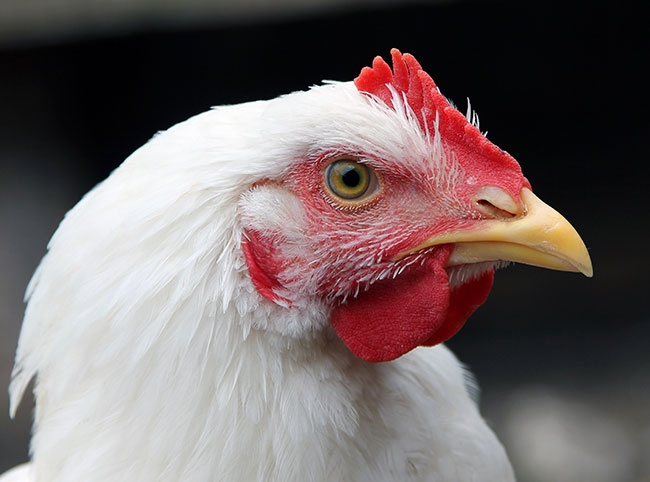
Trace minerals support bird health
By Lilian Schaer
Features Bird Management Production annex Canada Livestock Production Nutrition Poultry Production Production United StatesFeeding less reactive trace minerals can increase broiler performance and health
 According to Jeff Cohen, vice-president of marketing and sales with Micronutrients, making the switch from the cheapest copper sulfate on the market to hydroxy would cost producers about half a cent per bird, but the benefit on feed conversion would be anywhere from 2.5 to 3.5 cents per bird. Photo: Getty Images
According to Jeff Cohen, vice-president of marketing and sales with Micronutrients, making the switch from the cheapest copper sulfate on the market to hydroxy would cost producers about half a cent per bird, but the benefit on feed conversion would be anywhere from 2.5 to 3.5 cents per bird. Photo: Getty ImagesSupplementing poultry rations with trace minerals like copper, zinc and manganese can help improve flock health and profitability.
Although trace minerals themselves are not new, the latest products coming to market in Canada are presenting an alternative to low cost and highly soluble sulfate-based minerals, as well as the more expensive organic trace minerals.
Trace minerals support bone and tissue development, reproduction, and basic health and growth.
Mineral feed ingredient company Micronutrients, which has been owned by Nutreco since 2016, produces hydroxy trace minerals for poultry diets. These are specialty trace minerals that, as a result of their unique chemical structure, improve the stability of premixes and feeds.
Two of Micronutrients’ three IntelliBond mineral source products – copper and zinc – are now available in Canada. A third, using manganese, is currently undergoing regulatory review by the Canadian Food Inspection Agency (CFIA) and has not yet been released onto the Canadian market.
According to company officials, hydroxy trace mineral products are less soluble than sulfate minerals, which means they’re less likely to react with other feed ingredients or cause damage to the gastrointestinal tract, and they’re less costly than organic trace minerals.
EXTOLLING BENEFITS
In a presentation at the International Production and Processing Expo in Atlanta this past winter, Micronturients’ technical sales manager, Dr. Kurt Perryman, stated supplementing poultry rations with hydroxy copper trace mineral reduces oxidative stress and can prevent the gastrointestinal tract damage that can occur when feeding birds copper sulfate.
He added that the company’s zinc product has higher bioavailability, meaning the birds are better able to make use of the mineral in their systems. This lowers the environmental impact of trace mineral feeding.
According to Jeff Cohen, vice-president of marketing and sales with Micronutrients, copper in broiler rations contributes to better gut health, making the birds grow more efficiently, and zinc improves feed conversion and breast meat yield.
“Both areas provide better economics for producers,” Cohen said. “Manganese is more difficult to research and determine significant areas of improvement, but research has shown us that getting trace inorganic sulfates out seems to help improve growth in breast meat yield.”
RETURN ON INVESTMENT
Micronutrients’ products fall between inorganic and organic trace minerals on the cost scale, and the company calculates the return on investment for producers in the United States at about one cent per bird for the copper supplement.
According to Cohen, making the switch from the cheapest copper sulfate on the market to hydroxy would cost producers about half a cent per bird, but the benefit on feed conversion would be anywhere from 2.5 to 3.5 cents per bird.
“We conservatively quote the benefit of improving feed conversion through improving the source of copper at a penny a bird,” Cohen said. “We grow nine billion birds a year in the U.S., so that’s $90 million a year.”
IMMUNE SYSTEM
Zinc shows similar feed conversion improvement numbers, but its real value lies in helping poultry better resist disease. In a world where antibiotic use in animal agriculture is becoming increasingly restrictive, zinc can play a key role in improving livestock immune system response, lessening the need for antibiotic use to combat disease.
“Our zinc and sometimes manganese help offset negative impacts of disease better than sulfate and at lower levels than sulfates,” Cohen said.
AVAILABILITY
The company estimates 70 per cent of all broilers in the United States use Micronutrients’ copper product, and that zinc is being used by over half of the top 15 U.S. broiler integrators.
In Canada, the copper product has been available for several years and use has been growing steadily, Cohen said. Zinc, by comparison, has only recently been approved for sale in Canada, so adoption is just beginning.
Manganese is currently undergoing regulatory review but is not yet approved in Canada; Cohen called the Canadian approval process “one of the strictest in the world.”
“Our emphasis on doing research and exploring mode of action is leading us in some exciting directions in terms of how trace minerals bolster the immune system, help animals grow more efficiently and provide protection against disease challenges,” Cohen said. “We’re seeing the same immune improvements in swine and in ruminants too. Minerals are like vitamins, they’re very basic to nutrition and solidly contribute in all species to nutrition.”
Two distributors in Canada currently sell the products; more information is available from Trouw Nutrition.
Print this page